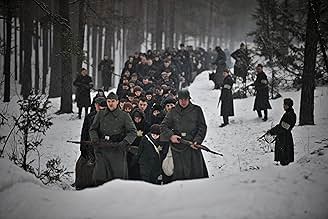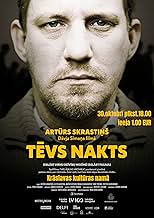Agrega una trama en tu idiomaZanis Lipke's family's efforts to save the Jews during World War II and the rise of the child in a tragic historical situation.Zanis Lipke's family's efforts to save the Jews during World War II and the rise of the child in a tragic historical situation.Zanis Lipke's family's efforts to save the Jews during World War II and the rise of the child in a tragic historical situation.
- Premios
- 5 premios ganados y 9 nominaciones en total
- Dirección
- Guionista
- Todo el elenco y el equipo
- Producción, taquilla y más en IMDbPro
Argumento
Opinión destacada
When it comes to one of the darkest moments in human history, we often only hear from two perspectives. Latvian film, The Mover screens as part of the curation in this year's Jewish International Film Festival and tells the true story of ordinarty blue-collar worker, Zanis Lipke, a 'sympathiser' of the persecuted during World War II.
Latvia has been the punching bag of warring countries, (then) U.S.S.R and Germany during this period, a term or clause in a non-aggression pact.
Davis Simanis Jr. shines new light on a controversial subject from the perspective of onlookers witnessing the savagery of the concentration camps. In context, the background to the film's setting is chilling. Riga harboured Jews extracted from Germany, Austria and Czech Republic. History tells us that 70,000 Jews were killed in Latvia during Nazi occupation after being forced to work in concentration camps for large German corporations. Standard policy at this time were for Jewish minors and those over 30 to be killed by gunfire.
The alliances of Latvian nationals is intricately tied to their experiences of attacks and occupation by Russia and Germany pitting neighbours, friends and families against one another. Further complicating the dynamic is the segregation and attack on the Jewish community. We watch Zanis Lipke's struggle, like many others who try to turn away from the devastation around him as it's the only way to survive under the new regime and protect his family.
Some powerful moments in the most simplest of dialogues include when Zanis' 5 year old son, asks why he turned away his schoolmate and her Jewish father after being asked to take her in. His elder adolescent son being called to serve in the German forces and the separation of Jews turning into physical destruction of his city, are major catalyst in the shift that takes place throughout the film. A few close calls and massacre of those he begins taking in at a local cinema and an underground bunker he creates aren't enough to detract him from continuing his dangerous work.
Not only does this film capture the horror of an era of inhumanity, but for the first time, so effectively, takes us into the mind of onlookers of the atrocities in a way that no history book can. Through Arturs Skrastins' (Zanis Lipke) stellar performance, the audience is taken deep into the challenge an outsider has in maintaining their humanity while an opportunity exists to prevent inhumanties from occuring. This is the core plot of the movie as history as we know it plays out in the film that chips away at Zanis' initial position.
Latvia has been the punching bag of warring countries, (then) U.S.S.R and Germany during this period, a term or clause in a non-aggression pact.
Davis Simanis Jr. shines new light on a controversial subject from the perspective of onlookers witnessing the savagery of the concentration camps. In context, the background to the film's setting is chilling. Riga harboured Jews extracted from Germany, Austria and Czech Republic. History tells us that 70,000 Jews were killed in Latvia during Nazi occupation after being forced to work in concentration camps for large German corporations. Standard policy at this time were for Jewish minors and those over 30 to be killed by gunfire.
The alliances of Latvian nationals is intricately tied to their experiences of attacks and occupation by Russia and Germany pitting neighbours, friends and families against one another. Further complicating the dynamic is the segregation and attack on the Jewish community. We watch Zanis Lipke's struggle, like many others who try to turn away from the devastation around him as it's the only way to survive under the new regime and protect his family.
Some powerful moments in the most simplest of dialogues include when Zanis' 5 year old son, asks why he turned away his schoolmate and her Jewish father after being asked to take her in. His elder adolescent son being called to serve in the German forces and the separation of Jews turning into physical destruction of his city, are major catalyst in the shift that takes place throughout the film. A few close calls and massacre of those he begins taking in at a local cinema and an underground bunker he creates aren't enough to detract him from continuing his dangerous work.
Not only does this film capture the horror of an era of inhumanity, but for the first time, so effectively, takes us into the mind of onlookers of the atrocities in a way that no history book can. Through Arturs Skrastins' (Zanis Lipke) stellar performance, the audience is taken deep into the challenge an outsider has in maintaining their humanity while an opportunity exists to prevent inhumanties from occuring. This is the core plot of the movie as history as we know it plays out in the film that chips away at Zanis' initial position.
- thenextrushmagazine
- 18 oct 2019
- Enlace permanente
Selecciones populares
Inicia sesión para calificar y agrega a la lista de videos para obtener recomendaciones personalizadas
- How long is The Mover?Con tecnología de Alexa
Detalles
- Fecha de lanzamiento
- País de origen
- Idiomas
- También se conoce como
- The Boy with the Dog
- Productora
- Ver más créditos de la compañía en IMDbPro
- Tiempo de ejecución1 hora 30 minutos
- Color
Contribuir a esta página
Sugiere una edición o agrega el contenido que falta

Principales brechas de datos
By what name was The Mover (2018) officially released in India in English?
Responda


















